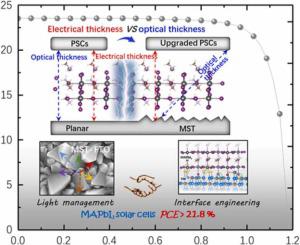Nano Energy ( IF 16.8 ) Pub Date : 2021-11-25 , DOI: 10.1016/j.nanoen.2021.106765 Fengyou Wang 1, 2 , Xin Li 1 , Jinyue Du 1, 2 , Hui Duan 1 , Haoyan Wang 1 , Yue Gou 1 , Lili Yang 1, 2, 3 , Lin Fan 1, 2 , Jinghai Yang 1, 2 , Federico Rosei 3

|
Due to the continuous increase in power conversion efficiencies (PCEs), perovskite solar cells (PSCs) are widely considered as the most promising technology for third generation photovoltaics. Improving optical absorption while reducing electrical losses is still a challenge towards attaining PCE values closer to the Shockley-Queisser limit. However, frequently used strategies to improve light absorption (e.g. via texturing the front surface) often cause electrical recombination losses. Here, we successfully relaxed the competing mechanisms between electrical and optical properties by integrating a modulated textured substrate and an amorphous metal nitride interface modification layer to combine enhanced light scattering and reducing interfacial recombination losses in PSCs. This comprehensive electro-optical management presents several advantages, including increased light absorption, promoting bandgap alignment and passivating the underlying perovskite defects. Consequently, the resulting MAPbI3 solar cells exhibit a high open-circuit voltage of 1.17 V and the concomitant high PCE of 21.84%. In addition, we also use numerical simulations to propose approaches towards achieving high efficiency (PCE>30%) PSCs. Besides expanding the pool of available strategies for improving the efficiency of PSCs, from photon management to interface engineering, our work also offers a systematic guidance for the design and fabrication of high performance photovoltaic devices.
中文翻译:

协调光管理和先进的金属氮化物中间层使 MAPbI3 太阳能电池具有 >21.8% 的效率
由于功率转换效率 ( PCE )的不断提高,钙钛矿太阳能电池 (PSC) 被广泛认为是最有前途的第三代光伏技术。在降低电损耗的同时提高光吸收率仍然是实现PCE的挑战值更接近肖克利-奎塞尔极限。然而,经常使用的提高光吸收的策略(例如通过纹理化前表面)通常会导致电复合损失。在这里,我们通过集成调制纹理衬底和非晶金属氮化物界面改性层,将增强的光散射和减少 PSC 中的界面复合损失相结合,成功地放松了电学和光学特性之间的竞争机制。这种全面的光电管理具有多种优势,包括增加光吸收、促进带隙对齐和钝化潜在的钙钛矿缺陷。因此,所得 MAPbI 3太阳能电池表现出 1.17 V 的高开路电压和伴随的高PCE21.84%。此外,我们还使用数值模拟来提出实现高效率(PCE > 30%)PSC 的方法。除了扩大用于提高 PSC 效率的可用策略池,从光子管理到界面工程,我们的工作还为高性能光伏器件的设计和制造提供了系统指导。


















































 京公网安备 11010802027423号
京公网安备 11010802027423号